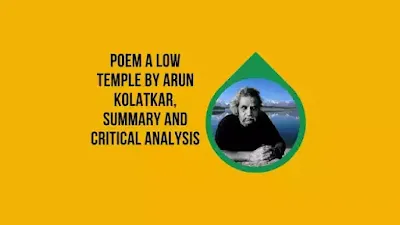Summary of the Poem:
The temple of Khandoba at Jejuri does not have a high ceiling. It is a rather low temple. Not much of sunlight can enter this low temple. The result is that the pilgrims cannot clearly see the various stone and bronze images or statues which are kept there. A pilgrim has to light a match in order to be able to see the images in its light. The protagonist (whose name, we later learn, is Manohar) offers a matchbox to the priest who lights a match so that the protagonist is able to see all the images one by one. The bronze image of one of the deities has an amused look on its face. A stone image of another deity seems to be smiling. Yet another image seems absolutely unsurprised by the presence of the devotees. When the matchstick has burned itself out, another matchstick is lighted so that the pilgrims (including the protagonist) can continue to see the images or statues of the various deities (the chief of whom is Khandoba).

Among the statues the protagonist sees one of a goddess which has eighteen arms. The protagonist asks the priest who this goddess is. The priest replies that it is the statue of a goddess having eight arms. But the protagonist says that he has counted eighteen arms. The priest still asserts that the statue is that of a goddess having eight arms. The protagonist, feeling puzzled, comes out of the temple into the sun, and lights a cigarette. He smokes charminar cigarettes. (Charminar is the name of a brand of cheap cigarettes which were extremely popular at one time but which nobody smokes these days). While the pilgrims are busy performing their rituals and offering their worship, the children are playing on the back of a stone statue of a tortoise which is twenty feet in height. (Even this tortoise is regarded as sacred).
Critical Analysis:
Kolatkar's disbelief in the divine attributes of the statues at Jejuri is evident in this poem. The priest says that the statue of the goddess has eight arms, while the protagonist has counted eighteen. To the protagonist's question, the priest is unable to give any satisfactory reply. In fact, the priest has hardly anything to say in reply; and the protagonist writes: “All the same she is still an eight - arm goddess to the priest.” The poet's scepticism is heightened by the protagonist's coming out in the sun and lighting a cigarette to smoke.
The last line, describing the children at play, is incidental; and yet it contains a vital bit of information. Outside the temple is the statue of a tortoise, twenty feet high; and the children climb up to the top of the statue to play on the back of the tortoise. There must be some holy belief relating to this statue also, though no indication of the nature of that belief has been supplied by the poet here.






